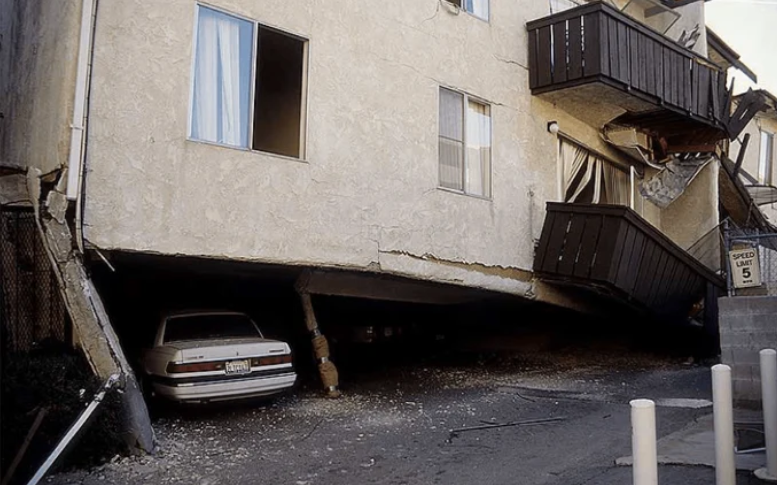Image: Soft-story apartment building collapse in the 1994 Northridge earthquake, L.A. Times
Soft-story buildings are susceptible to collapse during earthquakes because the ground floor is too weak to support the weight of the upper floors, endangering both structures and lives. The City of San Jose estimates there are about 3,500 soft-story buildings in San José, home to around 72,000 people. Soft-story buildings have large openings on the ground floor, such as a parking garage or retail space, which leaves the building without the necessary interior walls to resist the lateral motion of an earthquake. This type of construction is typical of most apartments built in the late-1960s and early-1970s, where parking spaces on the first floor, often referred to as “tuck-under parking,” provide insufficient structural support for the above apartment units.
At the time they were constructed, these buildings met the building codes and structural requirements, but over time, they have proven to be highly vulnerable to collapse and failure in earthquakes. The 1994 Northridge earthquake in Los Angeles brought this vulnerability to the attention of the engineering community and building departments. That event resulted in 57 deaths and more than 8,700 injured persons, the majority as the result of the catastrophic collapse of soft-story buildings. After years of work assessing the prevalence, risks, and potential solutions for soft-story buildings, San Jose’s City Council adopted an ordinance to address the issue on September 24, 2024. The ordinance requires soft-story apartments throughout the city to be retrofitted. It includes a timetable for the work to be completed, a framework to defray some of the costs for landlords, and provisions to limit the retrofit cost that can be passed on to tenants of soft-story apartments.
As an organization dedicated to ensuring every resident of Santa Clara County has access to a safe, stable home they can afford, SV@Home was pleased to see the Council considering real, concrete solutions to the physical vulnerability of residents of soft-story buildings. We agree that ensuring the safety of these buildings is crucial, not only to preserve this important stock of less expensive housing but also to prevent injury and loss of life in the event of an earthquake. This is a unique challenge in a city with a large amount of soft-story housing, home to some of the city’s most vulnerable residents. And the cost of retrofitting these homes is substantial.
Impact of cost on tenants
The adopted ordinance provides some guardrails on the ability of landlords to fund these required renovations by increasing the rent of the people living in the homes. The ordinance limits the annual increases to the 5% cap currently allowed under the City’s Apartment Rent Ordinance. However, the analyses provided by staff do not include an assessment of the risk of tenant displacement from San Jose or into homelessness due to the allowable rent increases.
As the Soft Story Seismic Retrofit Ordinance memo (9/12/24) notes, many soft-story housing residents live at the lowest income levels. The City’s research indicates that from 2019 through 2023, for units in the city’s ARO program (many of which are in soft-story buildings), 45% of landlords did not increase rents. The remaining 55% of landlords averaged a rent increase of only 2.4% year-over-year. This behavior by landlords indicates that they are already charging the price the market will bear for their units and that existing tenants cannot afford the allowed 5% annual rent increase. Further, a 2020 study by the U.S. Government Accountability Office finds that for every $100 increase in median rent, homelessness increases by 9%.
The City Council agreed that the potential financial impact on tenants and the risk for displacement and homelessness has not yet been adequately assessed by the City of San Jose. They directed staff to conduct further research on the impact that this ordinance would have on tenants in soft-story buildings, cross-referenced with data around tenants that are currently rent-burdened and extremely rent-burdened, to capture the potential impact of a 5% rent increase on already vulnerable households. Staff will also continue to monitor the impact of the program on tenants and landlords throughout program implementation.
Use of Measure E funding
Staff’s recommendation included diverting $61,000,000 of Measure E funding, at $6.1 million annually over ten years, to provide rebates to landlords who have completed necessary soft-story retrofits. Measure E has been the City’s largest funding source for affordable housing since it was passed by voters in 2020 with an adopted expenditure plan that reserved 90% of the funds for building affordable homes. Local funding, such as Measure E, helps bridge the gap between other available funding sources and the cost of producing housing for many of the city’s residents who can only afford rents that are below market rates.
Notably, the housing improved by the program, although primarily covered by the City’s Apartment Rent Ordinance (ARO), will not be deed-restricted to remain affordable to lower-income renters. Council directed staff to continue to seek alternative sources of funding for low-interest loans and rebate funds outside of Measure E dollars for this soft-story program. These sources would sustain Measure E funds to produce and preserve deed-restricted affordable housing and further offset retrofit costs to reduce the potential impact on tenants.
Council support
We appreciate the memo authored by Councilmembers Ortiz, Jimenez, and Torres which shares many of our concerns, as well as a memo from Councilmembers Foley, Davis, and Jimenez and a memo from the Mayor. Council adopted most of the recommendations from the three memos, helping to keep San Jose families safe and housed under equitable living conditions. Preventing resident displacement includes ensuring that rent increases due to a City-mandated program do not undermine everyone’s access to an affordable home.
